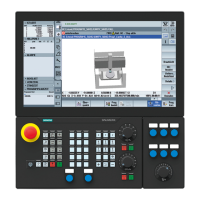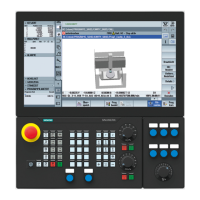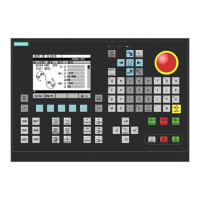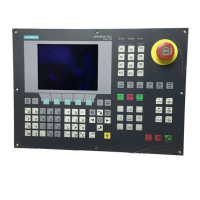Detailed Description
2.4 Frames
Axis Types, Coordinate Systems, Frames (K2)
2-94 Function Manual, 08/2005 Edition, 6FC5397-0BP10-0BA0
; Approach the corner
g1 x0 y0
; Retract the rectangle rotated about 30 degrees
g1 x10
y10
x0
y0
m30
2.4.8.2 Additive frame in frame chain
Measurements on the workpiece or calculations in the part program and cycles generally
produce a frame that is applied additively to the current complete frame. The WCS and thus
the programming zero must, therefore, be displaced and possibly rotated. This measured
frame is available as a temporary frame and not yet actively included in the frame chain. This
function is used to calculate and possible activate this frame:
INT ADDFRAME( FRAME, STRING )
Parameter 1: Type: FRAME ; Additive measured or calculated frame
; Strings for current frames:
; "$P_CYCFRAME", "$P_PFRAME", "$P_WPFRAME",
; "$P_TOOLFRAME", "$P_IFRAME",
; "$P_CHBFRAME[0..16]", "$P_NCBFRAME[0..16]",
; "$P_EXTFRAME", "$P_SETFRAME"
; "$P_PARTFRAME"
; Strings for data management frames
; "$P_CYCFR", "$P_TRAFR", "$P_WPFR",
; "$P_TOOLFR", "$P_UIFR[0..99]",
; "$P_CHBFR[0..16]", "$P_NCBFR[0..16]",
Parameter 2: Type: STRING
; "$P_EXTFR", "$P_SETFR", "$P_PARTFR"
; 0: OK
; 1: Specified target (string) is wrong
; 2: Target frame is not configured
Function value Type: INT
; 3: Rotation in frame is not permitted
The ADDFRAME() function calculates the target frame, which is specified by the STRING.
The target frame is calculated such that the new complete frame comprises a chain of the
old complete frame and the transferred frame, e.g.:
ERG = ADDFRAME( TMPFRAME, "$P_SETFRAME" )
The new complete frame is calculated to be:
$P_ACTFRAME
new
= $P_ACTFRAME
old
: TMPFRAME

